Strain-Relief Patterns and Kagome Lattice in Self-Assembled C60 Thin Films Grown on Cd(0001)
Abstract
1. Introduction
2. Results and Discussion
2.1. An Individual C60 Seven-Molecule Cluster at Two Bias Voltage
2.2. Wavy Structure of the C60 Submonolayer Appears at 100 K
2.3. High-Resolution Topological Graph of the Edge Dislocation
2.4. Two Regular Domains in R26° and R33°
2.5. A larger 4 × 4 Superstructure of Kagome Lattice in an R44° Domain
3. Materials and Methods
4. Conclusions
Author Contributions
Funding
Institutional Review Board Statement
Informed Consent Statement
Data Availability Statement
Conflicts of Interest
References
- Wachowiak, A.; Yamachika, R.; Khoo, K.H.; Wang, Y.; Grobis, M.; Lee, D.H.; Louie, S.G.; Crommie, M.F. Visualization of the molecular jahn-teller effect in an insulating K4C60 monolayer. Science 2005, 310, 468–470. [Google Scholar] [CrossRef] [PubMed]
- Feng, M.; Zhao, J.; Petek, H. Atomlike, Hollow-core–bound molecular orbitals of C60. Science 2008, 320, 359–362. [Google Scholar] [CrossRef] [PubMed]
- Mitrano, M.; Cantaluppi, A.; Nicoletti, D.; Kaiser, S.; Perucchi, A.; Lupi, S.; Pietro, P.D.; Pontiroli, D.; Riccò, M.; Clark, S.R.; et al. Possible light-induced superconductivity in K3C60 at high temperature. Nature 2016, 530, 461–464. [Google Scholar] [CrossRef]
- Schull, G.; Berndt, R. Orientationally ordered (7 × 7) superstructure of C60 on Au(111). Phys. Rev. Lett. 2007, 99, 226105. [Google Scholar] [CrossRef] [PubMed]
- Gardener, J.A.; Briggs, G.A.D.; Castell, M.R. Scanning tunneling microscopy studies of C60 monolayers on Au(111). Phys. Rev. B 2009, 80, 235434. [Google Scholar] [CrossRef]
- Wang, Y.Y.; Yamachika, R.; Wachowiak, A.; Grobis, M.; Khoo, K.H.; Lee, D.H.; Louie, S.G.; Crommie, M.F. Novel Orientational Ordering and Reentrant Metallicity in KxC60 Monolayers for 3 ≤ x ≤ 5. Phys. Rev. Lett. 2007, 99, 086402. [Google Scholar] [CrossRef]
- Tang, L.; Xie, Y.C.; Guo, Q.M. Complex orientational ordering of C60 molecules on Au(111). J. Chem. Phys. 2011, 135, 114702. [Google Scholar] [CrossRef]
- Tang, L.; Guo, Q.M. Orientational ordering of the second layer of C60 molecules on Au(111). Phys. Chem. Chem. Phys. 2012, 14, 3323–3328. [Google Scholar] [CrossRef] [PubMed]
- Shin, H.; Schwarze, A.; Diehl, R.D.; Pussi, K.; Colombier, A.; Gaudry, E.; Ledieu, J.; McGuirk, G.M.; Serkovic, L.L.N.; Fournee, V.; et al. Structure and dynamics of C60 molecules on Au(111). Phys. Rev. B 2014, 89, 245428. [Google Scholar] [CrossRef]
- Grobis, M.; Lu, X.; Crommie, M.F. Local electronic properties of a molecular monolayer: C60 on Ag(001). Phys. Rev. B 2002, 66, 161408. [Google Scholar] [CrossRef]
- Pai, W.W.; Hsu, C.L. Ordering of an incommensurate molecular layer with adsorbate-induced reconstruction:C60/Ag(100). Phys. Rev. B 2003, 68, 121403. [Google Scholar] [CrossRef]
- Hsu, C.L.; Pai, W.W. Aperiodic incommensurate phase of a C60 monolayer on Ag(100). Phys. Rev. B 2003, 68, 245414. [Google Scholar] [CrossRef]
- Pai, W.W.; Hsu, C.L.; Lin, K.C.; Sin, L.Y.; Tang, T.B. Characterization and control of molecular ordering on adsorbate-induced reconstructed surfaces. Appl. Surf. Sci. 2005, 241, 194–198. [Google Scholar] [CrossRef]
- Grobis, M.; Yamachika, R.; Wachowiak, A.; Lu, X.H.; Crommie, M.F. Phase separation and charge transfer in a K-doped C60 monolayer on Ag(001). Phys. Rev. B 2007, 80, 073410. [Google Scholar] [CrossRef]
- Abel, M.; Dmitriev, A.; Fasel, R.; Lin, N.; Barth, J.V.; Kern, K. Scanning tunneling microscopy and x-ray photoelectron diffraction investigation of C60 films on Cu(100). Phys. Rev. B 2003, 67, 245407. [Google Scholar] [CrossRef]
- Wong, S.S.; Pai, W.W.; Chen, C.H.; Lin, M.T. Coverage-dependent adsorption superstructure transition of C60/Cu(001). Phys. Rev. B 2010, 82, 125442. [Google Scholar] [CrossRef]
- Li, H.I.; Franke, K.J.; Pascual, J.I.; Bruch, L.W.; Diehl, R.D. Origin of Moiré structures in C60 on Pb(111) and their effect on molecular energy levels. Phys. Rev. B 2009, 80, 085415. [Google Scholar] [CrossRef]
- Weckesser, J.; Cepek, C.; Fasel, R.; Barth, J.V.; Baumberger, F.; Greber, T.; Kern, K. Binding and ordering of C60 on Pd(110): Investigations at the local and mesoscopic scale. J. Chem. Phys. 2001, 115, 9001–9009. [Google Scholar] [CrossRef]
- Cui, X.X.; Han, D.; Guo, H.L.; Zhou, L.W.; Qiao, J.S.; Liu, Q.; Cui, Z.H.; Li, Y.F.; Lin, C.W.; Cao, L.M.; et al. Realizing nearly-free-electron like conduction band in a molecular film through mediating intermolecular van der waals interactions. Nat. Commun. 2019, 10, 3374. [Google Scholar] [CrossRef] [PubMed]
- Ledieu, J.; Gaudry, E.; Weerd, M.C.D.; Gille, P.; Diehl, R.D.; Fournee, V. C60 superstructure and carbide formation on the Al-terminated Al9Co2(001) surface. Phys. Rev. B 2015, 91, 155418. [Google Scholar] [CrossRef]
- Li, G.; Zhou, H.T.; Pan, L.D.; Zhang, Y.; Mao, J.H.; Zou, Q.; Guo, H.M.; Wang, Y.L.; Du, S.X.; Gao, H.J. Self-assembly of C60 monolayer on epitaxially grown, nanostructured graphene on Ru(0001) surface. Appl. Phys. Lett. 2012, 100, 013304. [Google Scholar] [CrossRef]
- Jung, M.; Shin, D.B.; Sohn, S.D.; Kwon, S.Y.; Park, N.J.; Shin, H.J. Atomically resolved orientational ordering of C60 molecules on epitaxial graphene on Cu(111). Nanoscale 2014, 6, 11835–11840. [Google Scholar] [CrossRef] [PubMed]
- Han, S.; Guan, M.X.; Song, C.L.; Wang, Y.L.; Ren, M.Q.; Meng, S.; Ma, X.C.; Xue, Q.K. Visualizing molecular orientational ordering and electronic structure in CsnC60 fulleride films. Phys. Rev. B 2020, 101, 085413. [Google Scholar] [CrossRef]
- Chen, C.H.; Zheng, H.S.; Mills, A.; Heflin, J.R.; Tao, C.G. Temperature evolution of quasi-one-dimensional C60 nanostructures on rippled graphene. Sci. Rep. 2015, 5, 14336. [Google Scholar] [CrossRef]
- Santos, E.J.G.; Scullion, D.; Chu, X.S.; Li, D.O.; Guisinger, N.P.; Wang, Q.H. Rotational superstructure in van der waals heterostructure of self-assembled C60 monolayer on the WSe2 surface. Nanoscale 2017, 9, 13245–13256. [Google Scholar] [CrossRef]
- Wang, H.Q.; Zeng, C.G.; Wang, B.; Hou, J.G. Orientational configurations of the C60 molecules in the (2 × 2) superlattice on a solid C60 (111) surface at low temperature. Phys. Rev. B 2001, 63, 085417. [Google Scholar] [CrossRef]
- Nakaya, M.; Aono, M.; Nakayama, T. Molecular-scale size tuning of covalently bound assembly of C60 molecules. ACS Nano. 2011, 5, 7830–7837. [Google Scholar] [CrossRef] [PubMed]
- Matetskiy, A.V.; Gruznev, D.V.; Zotov, A.V.; Saranin, A.A. Modulated C60 monolayers on Si(111)√3 × √3-Au reconstructions. Phys. Rev. B 2011, 83, 195421. [Google Scholar] [CrossRef]
- Gruznev, D.V.; Matetskiy, A.V.; Bondarenko, L.V.; Utas, O.A.; Zotov, A.V.; Saranin, A.A.; Chou, J.P.; Wei, C.M.; Lai, M.Y.; Wang, Y.L. Stepwise self-assembly of C60 mediated by atomic scale moire’ magnifiers. Nat. Commun. 2013, 4, 1679. [Google Scholar] [CrossRef] [PubMed][Green Version]
- Xu, H.; Chen, D.M.; Creager, W.N. C60-induced reconstruction of the Ge(111) surface. Phys. Rev. B 1994, 50, 8454–8459. [Google Scholar] [CrossRef] [PubMed]
- Klyachko, D.V.; Lopez-Castillo, J.M.; Jay-Gerin, J.P.; Chen, D.M. Stress relaxation via the displacement domain formation in films of C60 on Ge(100). Phys. Rev. B 1999, 60, 9026–9036. [Google Scholar] [CrossRef]
- Fanetti, M.; Gavioli, L.; Cepek, C.; Sancrotti, M. Orientation of C60 molecules in the (3√3 × 3√3) R30° and (√13 × √13) R14° phases of C60/Ge(111) single layers. Phys. Rev. B 2008, 77, 085420. [Google Scholar] [CrossRef]
- Torrelles, X.; Pedio, M.; Cepek, C.; Felici, R. (2√3 × 2√3) R30° induced self-assembly ordering by C60 on a Au(111) surface: X-ray diffraction structure analysis. Phys. Rev. B 2012, 86, 075461. [Google Scholar] [CrossRef]
- Passens, M.; Waser, R.; Karthaeuser, S. Enhanced fullerene-Au(111) coupling in (2√3 × 2√3) R30° superstructures with intermolecular interactions. Beilstein J. Nanotechnol. 2015, 6, 1421–1431. [Google Scholar] [CrossRef] [PubMed]
- Thürmer, K.; Huang, R.Q.; Bartelt, N.C. Surface self-organization caused by dislocation networks. Science 2006, 311, 1272–1274. [Google Scholar] [CrossRef]
- Lu, Y.F.; Przybylski, M.; Trushin, O.; Wang, W.H.; Barthel, J.; Granato, E.; Ying, S.C.; Nissila, T.A. Strain relief in Cu-Pd heteroepitaxy. Phys. Rev. Lett. 2005, 94, 146105. [Google Scholar] [CrossRef]
- Hsu, P.J.; Finco, A.; Schmidt, L.; Kubetzka, A.; Bergmann, K.V.; Wiesendanger, R. Guiding spin spirals by local uniaxial strain relief. Phys. Rev. Lett. 2016, 116, 017201. [Google Scholar] [CrossRef] [PubMed]
- Realpe, H.; Peretz, E.; Shamir, N.; Mintz, M.H.; Shneck, R.Z.; Manassen, Y. Islands as nanometric probes of strain distribution in heterogeneous surfaces. Phys. Rev. Lett. 2010, 104, 056102. [Google Scholar] [CrossRef] [PubMed]
- Liu, F.; Tersoff, J.; Lagally, M.G. Self-organization of steps in growth of strained films on vicinal substrates. Phys. Rev. Lett. 1998, 80, 1268–1271. [Google Scholar] [CrossRef]
- Mo, Y.W.; Savage, D.E.; Swartzentruber, B.S.; Lagally, M.G. Kinetic pathway in stranski-krastanov growth of Ge on Si(001). Phys. Rev. Lett. 1990, 65, 1020–1023. [Google Scholar] [CrossRef]
- Mansour, K.A.; Buchsbaum, A.; Ruffieux, P.; Schmid, M.; Gröning, P.; Varga, P.; Fasel, R.; Gröning, O. Fabrication of a well-ordered nanohole array stable at room temperature. Nano Lett. 2008, 8, 2035–2040. [Google Scholar] [CrossRef]
- Jankowski, M.; Wormeester, H.; Zandvliet, H.J.W.; Poelsema, B. Temperature dependent formation and evolution of the interfacial dislocation network of Ag/Pt (111). Phys. Rev. B 2014, 89, 235402. [Google Scholar] [CrossRef]
- Lai, M.Y.; Wang, Y.L. Metal/semiconductor incommensurate structure with a rare domain configuration exhibiting p31m symmetry. Phys. Rev. B 2000, 61, 12608–12611. [Google Scholar] [CrossRef]
- Zegenhagen, J.; Fontes, E.; Grey, F.; Patel, J.R. Microscopic structure, discommensurations, and tiling of Si(111)/Cu “5 × 5”. Phys. Rev. B 1992, 46, 1860–1863. [Google Scholar] [CrossRef] [PubMed]
- Gorji, N.E.; Tanner, B.K.; Vijayaraghavan, R.K.; Danilewsky, A.N.; McNally, P.J. Nondestructive, in situ mapping of die surface displacements in encapsulated IC chip packages using x-ray diffraction imaging techniques. In Proceedings of the IEEE Electronic Components and Technology Conference, Orlando, FL, USA, 30 May–2 June 2017. [Google Scholar] [CrossRef]
- Xie, Z.B.; Wang, Y.L.; Tao, M.L.; Sun, K.; Tu, Y.B.; Yuan, H.K.; Wang, J.Z. Ordered array of CoPc-vacancies filled with single-molecule rotors. Appl. Surf. Sci. 2018, 439, 462–467. [Google Scholar] [CrossRef]
- Yang, D.X.; Wang, Z.L.; Shi, M.X.; Sun, K.; Tao, M.L.; Yang, J.Y.; Wang, J.Z. Orientational transition of tin phthalocyanine molecules in the self-assembled monolayer. J. Phys. D Appl. Phys. 2020, 53, 154004. [Google Scholar] [CrossRef]
- Heiney, P.A.; Fischer, J.E.; Mcghie, A.R.; Romanow, W.J.; Denenstein, A.M.; Mccauley, J.P.; Smith, A.B.; Cox, D.E. Orientational ordering transition in solid C60. Phys. Rev. Lett. 1991, 66, 2911–2914. [Google Scholar] [CrossRef]
- Kotlyar, V.G.; Olyanich, D.A.; Utas, T.V.; Zotov, A.V.; Saranin, A.A. Self-assembly of C60 fullerenes on quasi-one-dimensional Si(111)4×1-in surface. Surf. Sci. 2012, 606, 1821–1824. [Google Scholar] [CrossRef]
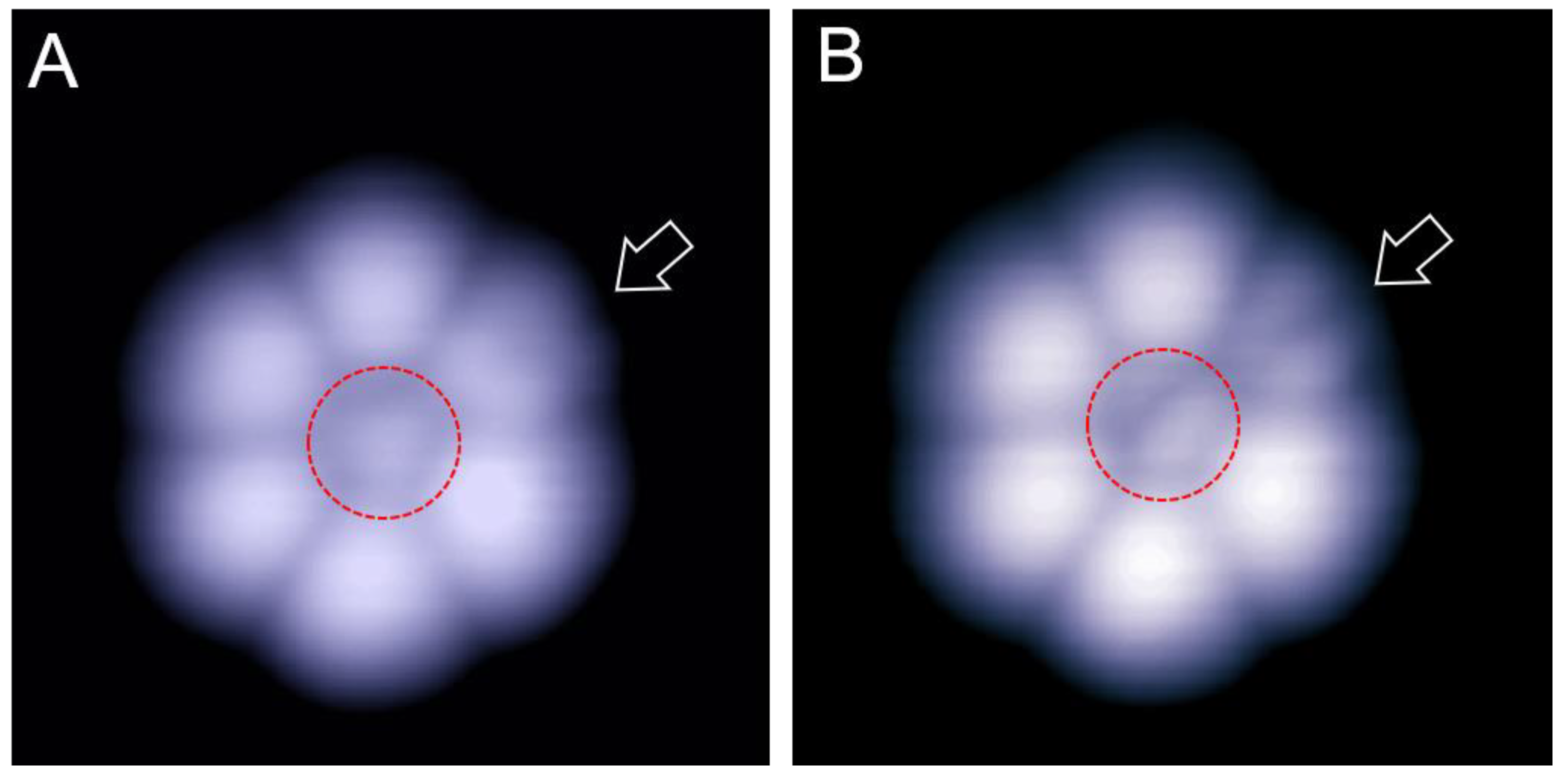
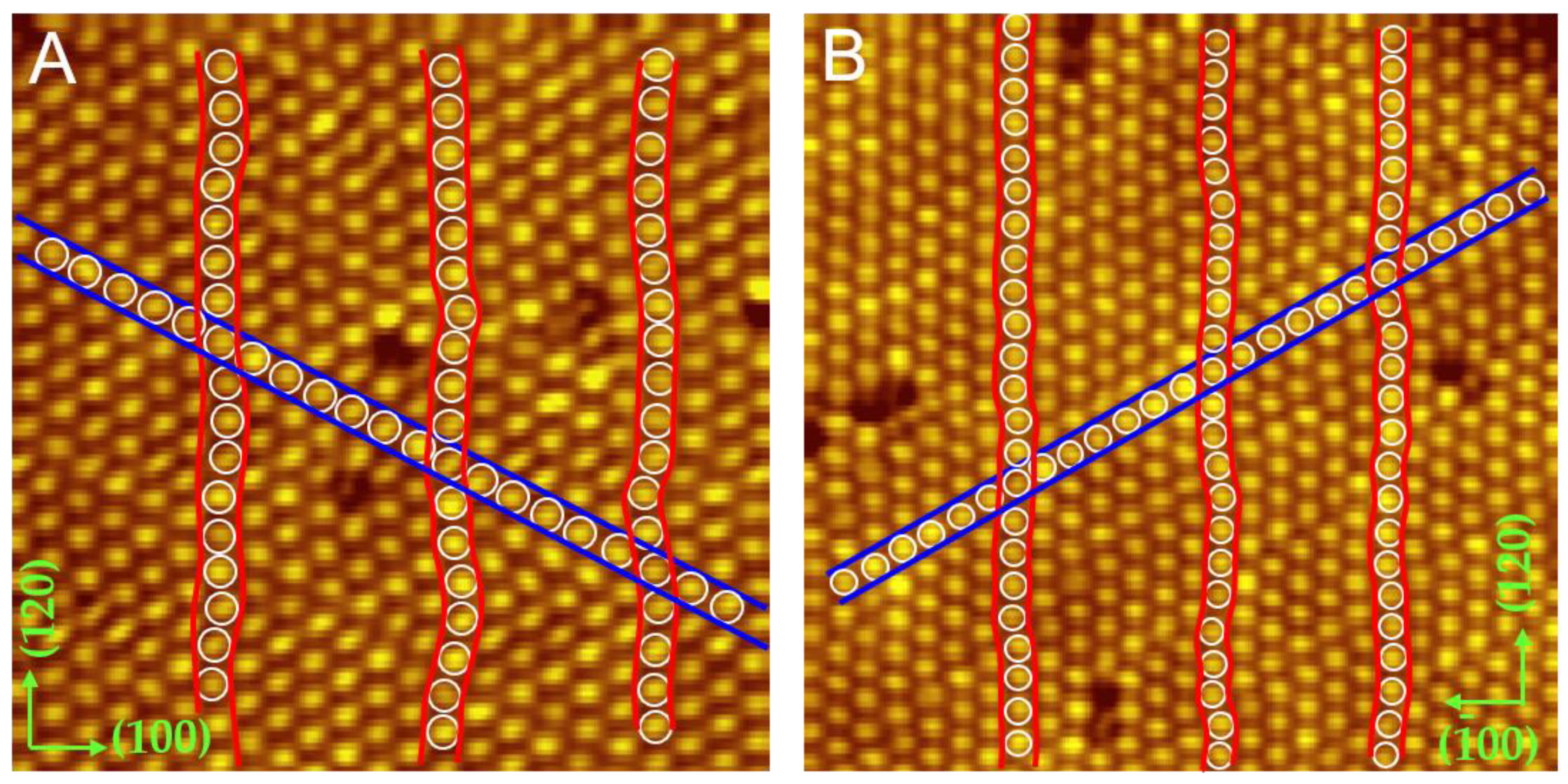
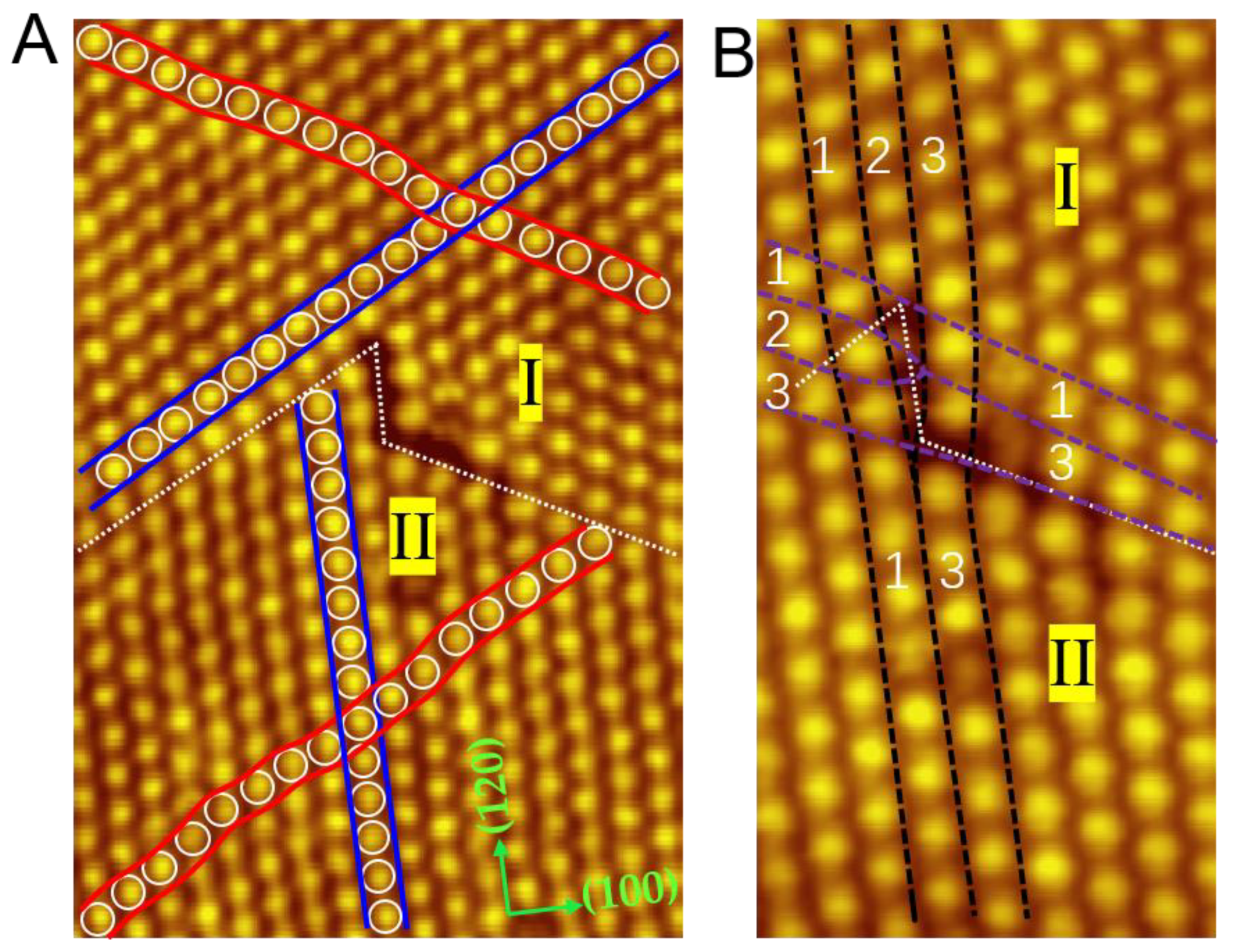
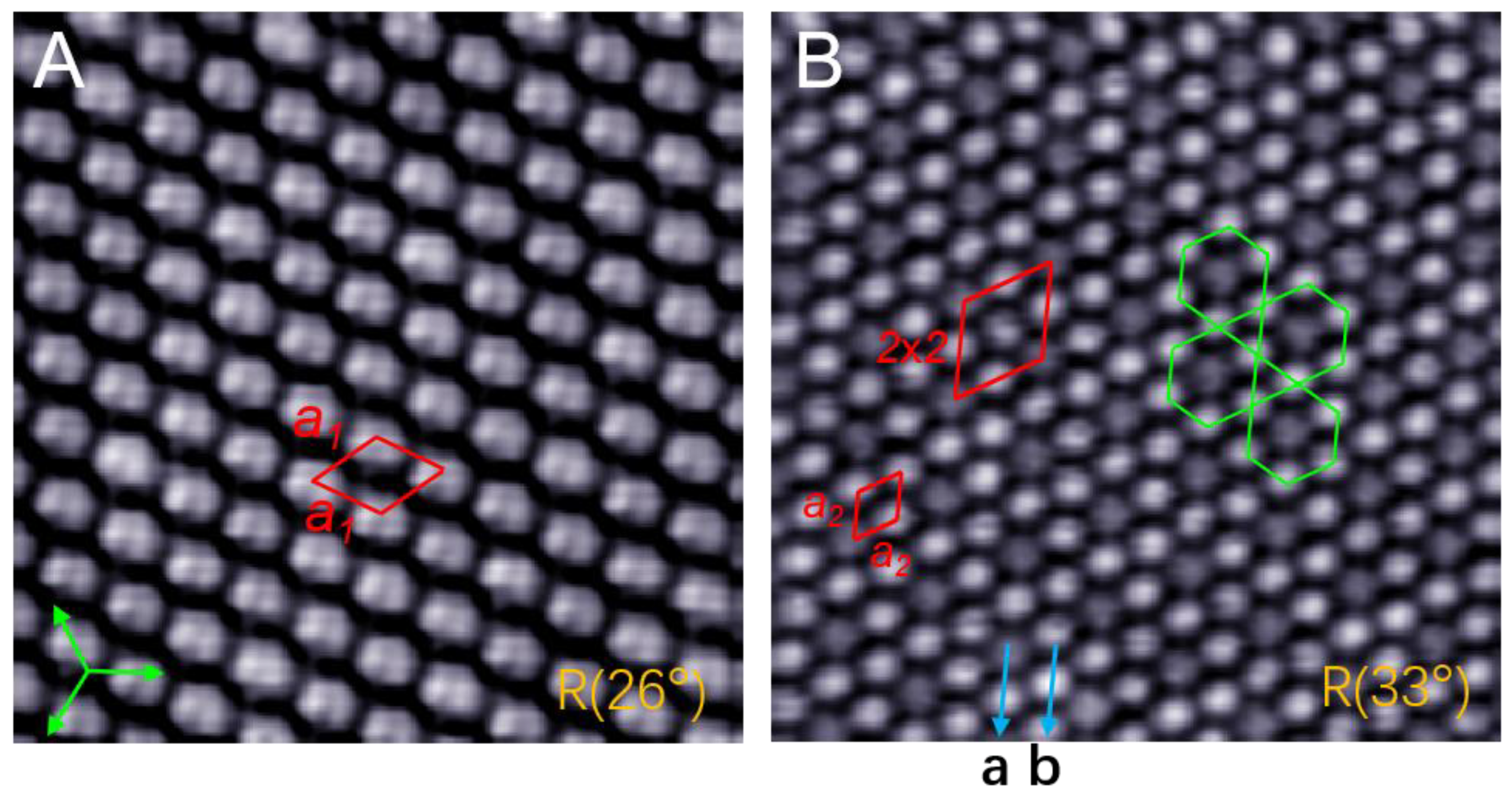
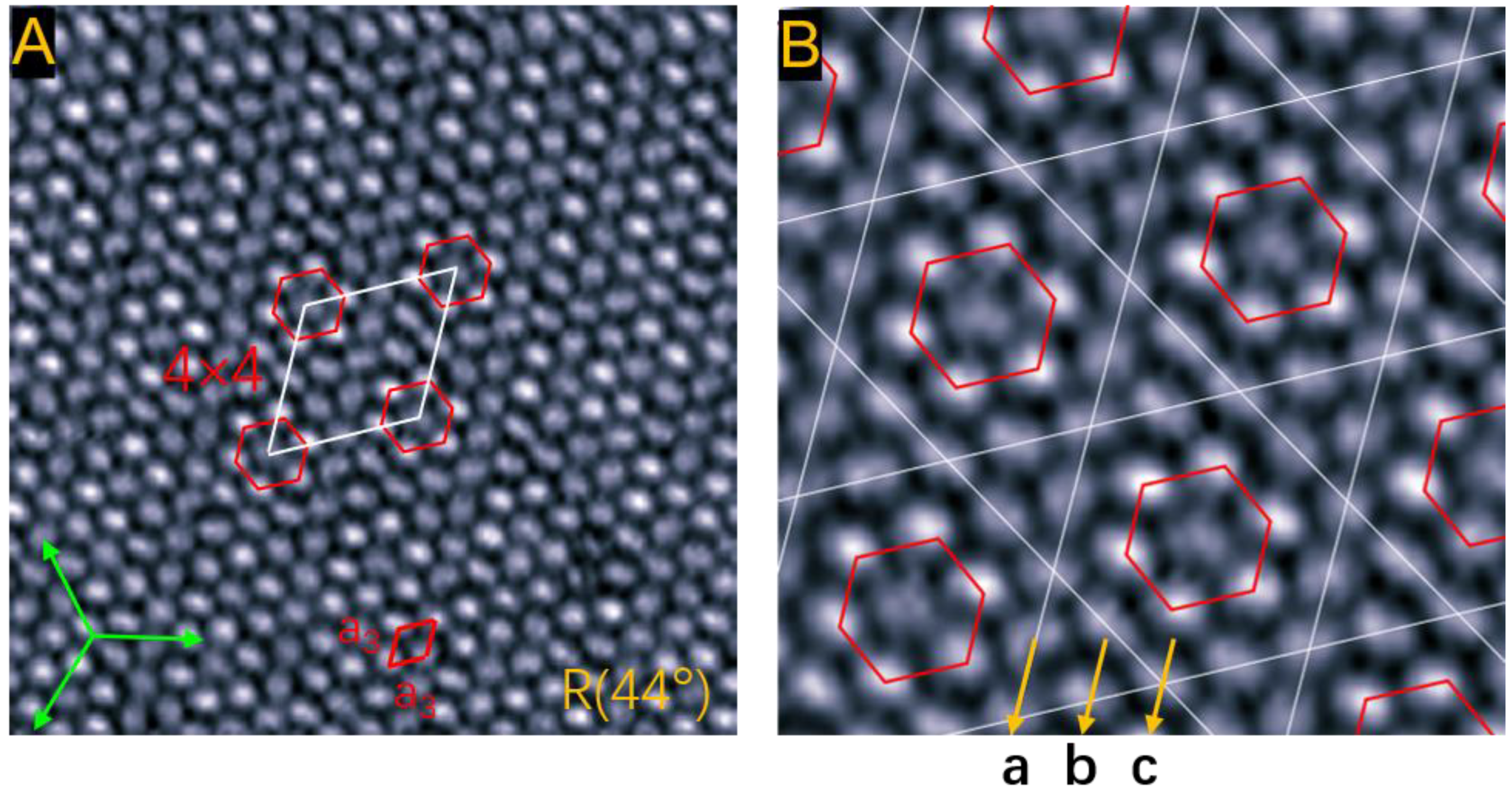
Publisher’s Note: MDPI stays neutral with regard to jurisdictional claims in published maps and institutional affiliations. |
© 2021 by the authors. Licensee MDPI, Basel, Switzerland. This article is an open access article distributed under the terms and conditions of the Creative Commons Attribution (CC BY) license (https://creativecommons.org/licenses/by/4.0/).
Share and Cite
Wang, Z.; Tao, M.; Yang, D.; Li, Z.; Shi, M.; Sun, K.; Yang, J.; Wang, J. Strain-Relief Patterns and Kagome Lattice in Self-Assembled C60 Thin Films Grown on Cd(0001). Int. J. Mol. Sci. 2021, 22, 6880. https://doi.org/10.3390/ijms22136880
Wang Z, Tao M, Yang D, Li Z, Shi M, Sun K, Yang J, Wang J. Strain-Relief Patterns and Kagome Lattice in Self-Assembled C60 Thin Films Grown on Cd(0001). International Journal of Molecular Sciences. 2021; 22(13):6880. https://doi.org/10.3390/ijms22136880
Chicago/Turabian StyleWang, Zilong, Minlong Tao, Daxiao Yang, Zuo Li, Mingxia Shi, Kai Sun, Jiyong Yang, and Junzhong Wang. 2021. "Strain-Relief Patterns and Kagome Lattice in Self-Assembled C60 Thin Films Grown on Cd(0001)" International Journal of Molecular Sciences 22, no. 13: 6880. https://doi.org/10.3390/ijms22136880
APA StyleWang, Z., Tao, M., Yang, D., Li, Z., Shi, M., Sun, K., Yang, J., & Wang, J. (2021). Strain-Relief Patterns and Kagome Lattice in Self-Assembled C60 Thin Films Grown on Cd(0001). International Journal of Molecular Sciences, 22(13), 6880. https://doi.org/10.3390/ijms22136880





